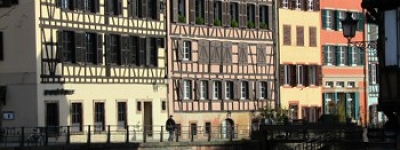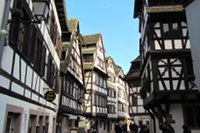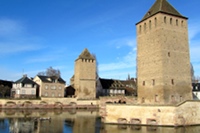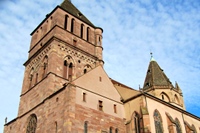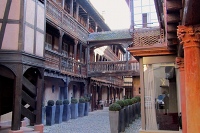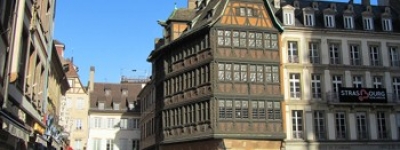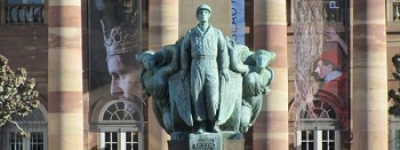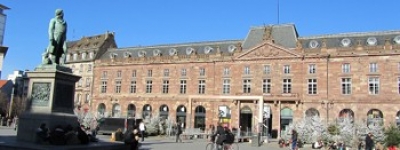The Petite France district, bounded by the covered bridges, the Ill River and Grand’Rue, is probably the most picturesque part of the city center, where you can stroll through its streets lined with beautiful half-timbered houses from the 16th and 17th century.
Far from the opulent mansions around the cathedral, it was the district of all those who needed water for life: fishermen, millers, tanners ... It was for these trades that the four arms of the Ill were created, channeled as early as the Middle Ages.
La rue du Bain aux Plantes
Do not miss this street lined with typical Alsatian houses of the tanners. Their staircase roofs were built to dry animal skins, as were the attics. At No. 42, the Maison des Tanneurs, which alone could symbolize this district, has inspired many artists.
Covered Bridges
The covered bridges are located on the outskirts of the district of the Petite France. From a military point of view, the separation of Ill into several branches represented the Achilles heel of the defensive system of the city in the 13th century. The covered bridges were built to solve this problem. Dominated by four massive towers, they define the city walls as early as the 14th century. They were protected by a tile roof and equipped with wooden louvers, allowing soldiers to remain covered in case of attack. Obsolete with the creation of the dam upstream, these bridge-galleries disappeared in 1784 in favor of the existing bridges in sandstone installed a century later.
The Vauban Dam
Place du quartier blanc - Rue Sainte-Marguerite, 67000 Strasbourg
Open every day 9 a.m. to 7:30 p.m.
In 1681, upon the incorporation of the city to the Kingdom of France, Vauban intervened. He considered the covered bridges archaic and unsuitable in case of attack. He decided to design a new system of defense. He built a dam upstream, preventing the advance of attackers. A lock system consisting of movable panels completed the iron fortification to flood the entire southern front in case of necessity. The dam was raised one level in 1865. In 1966, the terrace was transformed into in walkway that offers a magnificent view of the Petite France district. Accessible via stairs or elevator.
Nearby
Church of Saint Pierre le Vieux
8 Rue du 22 novembre, 67000 Strasbourg
The Church of Saint Pierre le Vieux is actually composed of two religious buildings. The first dates from the 13th century and was dedicated to Protestant worship from the 16th century onward. In 1683, two years after the conquest of Strasbourg, Louis XIV ordered the return of the choir to the Catholic Church. It would be expanded in 1866 perpendicular to the first church (which is still Protestant).
From the Middle Ages, there remains only the base of the tower (8th century), the nave and the jube (15th century). A wonderful buffet and Silbermann organ was installed above the jube in 1709. Some masterpieces adorn the interior: in the choir, the paintings of the Passion of Christ dating from the late 15th century and the remains of a carved altarpiece recount episodes from the life of Saint Peter and Christ.
Saint Thomas Church
Place Saint-Thomas, 67000 Strasbourg
Website
Open daily:
November through March: 10 a.m. to 5 p.m. ; April through October: 10 a.m. to 6 p.m.
Sundays : 2 p.m. . to 5 p.m. Sunday mornings are reserved for services.
Guided tours in French or German are possible. Information and reservations: tel : 03 88 32 14 46.
Accessible to those with reduced mobility upon request.
This church (Protestant), is the largest of the city after the cathedral. It presents an original architecture with its church hall consisting of five vessels. Built in a Gothic style, it is nevertheless very simple, even austere. It houses the impressive mausoleum of Marshall de Saxe, considered a masterpiece of Baroque funerary art of the 18th century. It was Louis XV who was behind the project to pay tribute to German military history in the service of France.
The mausoleum is decorated with a unique sculpture by Pigalle which depicts the Marshall de Saxe making his way toward his tomb, opened by Death, while a woman, symbol of France, tries to prevent it. Animals symbolize the enemy nations of France (the lion for Holland, the eagle for Germany and the leopard for England). Mozart played on the church organ, made by Silbermann in 1741.
Nearby: Commanderie Saint-Jean - École Nationale d'Administration
1 Rue Sainte-Marguerite, 67000 Strasbourg
In the 14th century, the Convent of the Knights of the Order of Saint John of Jerusalem was located at the site of the present National School of Administration, which trains the political elites of the country. A hospital was established there in the 16th century. The paintings on the facade date from this period. After the Knights of Saint John, the buildings were used as a prison until 1988 before the ENA settled there.

